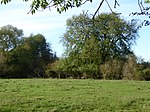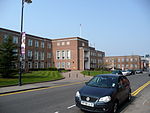Old Field, Bray
1775 establishments in EnglandBerkshire building and structure stubsBray, BerkshireCricket grounds in BerkshireCricket in Berkshire ... and 9 more
Defunct cricket grounds in EnglandDefunct sports venues in BerkshireEnglish cricket ground stubsEnglish cricket venues in the 18th centuryHistory of BerkshireSport in BerkshireSports venues completed in 1775Sports venues in BerkshireUse British English from February 2023
Old Field at Bray, Berkshire was a noted cricket ground in the late 18th century. It was used as the venue for four first-class matches between 1792 and 1795 in addition to several minor matches.Bray is near Maidenhead and the ground was the home venue of Maidenhead Cricket Club when it was founded in the second half of the 18th century. It was used for first-class matches by the Berkshire county team which was very strong at that time. The name of the venue has also been given as "Old Field, Bray" but the designation "Oldfield Bray" is given by Scores and Biographies which also calls the Berkshire team "Oldfield" in one match.
Excerpt from the Wikipedia article Old Field, Bray (License: CC BY-SA 3.0, Authors).Old Field, Bray
Bray Road,
Geographical coordinates (GPS) Address Nearby Places Show on map
Geographical coordinates (GPS)
| Latitude | Longitude |
|---|---|
| N 51.518 ° | E -0.71 ° |
Address
Bray Road
Bray Road
SL6 1UF , Bray Wick
England, United Kingdom
Open on Google Maps











